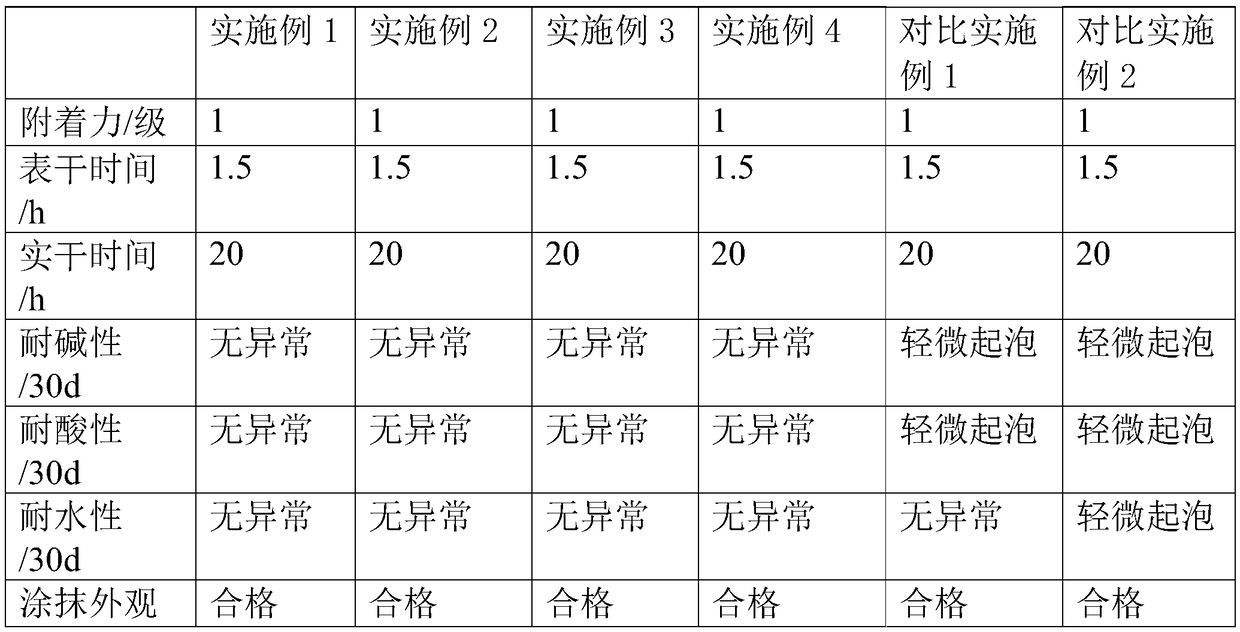Polyaspartic acid ester finishing paint as well as preparation method and application thereof
A technology of aspartic acid ester and polyisocyanate, which is applied in polyamide coatings, coatings, anti-corrosion coatings, etc., can solve the problems of poor wettability of substrate materials, poor aging resistance, and poor surface effects, and achieve mechanical Excellent performance, good weather resistance, and the effect of improving adhesion
- Summary
- Abstract
- Description
- Claims
- Application Information
AI Technical Summary
Problems solved by technology
Method used
Image
Examples
Embodiment 1
[0026] (1) Mix 85 parts of elastic isocyanate curing agent with 15 parts of aliphatic polyisocyanate trimer to prepare component A.
[0027] (2) Polystyrene graft modified glass flakes
[0028] ① Add 100 parts of glass flakes and 1 part of silane coupling agent into the container, and mechanically stir at room temperature for 15 minutes to obtain glass flakes treated with silane coupling agent.
[0029] ②Mix 1 part of glass flakes treated with silane coupling agent, 10 parts of distilled water and 90 parts of ethanol evenly, then oscillate ultrasonically for 30 minutes, pour it into a 500mL three-necked flask, and control the stirring speed at 450rpm; mix 10 parts of styrene and 2 parts of AIBN After mixing evenly, pour it into the above-mentioned three-necked flask at one time, under nitrogen protection, and react at a temperature of 60° C. for 24 hours. After the end, centrifuge and dry to obtain polystyrene grafted modified glass flakes.
[0030] (3) Preparation of B comp...
Embodiment 2
[0036] (1) Mix 70 parts of elastic isocyanate curing agent with 30 parts of aliphatic polyisocyanate trimer to prepare component A.
[0037] (2) Polystyrene graft modified glass flakes
[0038] ① Add 100 parts of glass flakes and 1 part of silane coupling agent into the container, and mechanically stir at room temperature for 15 minutes to obtain glass flakes treated with silane coupling agent.
[0039] ②Mix 1 part of glass flakes treated with silane coupling agent, 10 parts of distilled water and 90 parts of ethanol evenly, then oscillate ultrasonically for 30 minutes, pour it into a 500mL three-necked flask, and control the stirring speed at 450rpm; mix 10 parts of styrene and 2 parts of AIBN After mixing evenly, pour it into the above-mentioned three-necked flask at one time, under nitrogen protection, and react at a temperature of 60° C. for 24 hours. After the end, centrifuge and dry to obtain polystyrene grafted modified glass flakes.
[0040] (3) Preparation of B comp...
Embodiment 3
[0046] (1) Mix 70 parts of elastic isocyanate curing agent with 30 parts of aliphatic polyisocyanate trimer to prepare component A.
[0047] (2) Polystyrene graft modified glass flakes
[0048] ① Add 100 parts of glass flakes and 1 part of silane coupling agent into the container, and mechanically stir at room temperature for 15 minutes to obtain glass flakes treated with silane coupling agent.
[0049] ②Mix 1 part of glass flakes treated with silane coupling agent, 10 parts of distilled water and 90 parts of ethanol evenly, then oscillate ultrasonically for 35 minutes, pour it into a 500mL three-necked flask, and control the stirring speed at 500rpm; mix 10 parts of styrene and 2 parts of AIBN After mixing evenly, pour it into the above-mentioned three-necked flask at one time, under nitrogen protection, and react at a temperature of 60° C. for 24 hours. After the end, centrifuge and dry to obtain polystyrene grafted modified glass flakes.
[0050] (3) Preparation of B compon...
PUM
 Login to View More
Login to View More Abstract
Description
Claims
Application Information
 Login to View More
Login to View More - R&D
- Intellectual Property
- Life Sciences
- Materials
- Tech Scout
- Unparalleled Data Quality
- Higher Quality Content
- 60% Fewer Hallucinations
Browse by: Latest US Patents, China's latest patents, Technical Efficacy Thesaurus, Application Domain, Technology Topic, Popular Technical Reports.
© 2025 PatSnap. All rights reserved.Legal|Privacy policy|Modern Slavery Act Transparency Statement|Sitemap|About US| Contact US: help@patsnap.com

